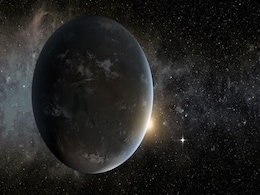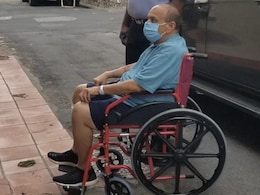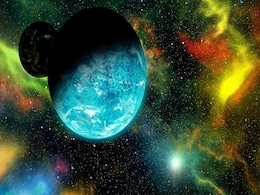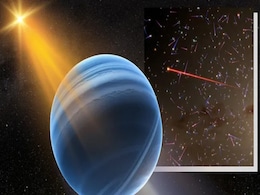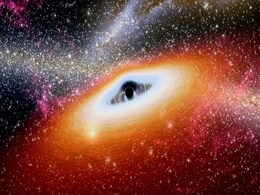Astronomical Discoveries
- All
- News
-

NASA Hubble Space Telescope Helps Confirm the First Solitary Black Hole
- Friday April 18, 2025
- Written by Gadgets 360 Staff
In the Sagittarius constellation, a lone and first-ever solitary black hole has been discovered by a team of scientists. Although the discovery began in the year 2011, the observations have confirmed it recently. The size of this black hole is as massive as seven times of the sun. Despite the conflicts and differences of observations by another tea...
-
 www.gadgets360.com
www.gadgets360.com
-

Signs of Alien Life Detected on Nearby Exoplanet Using NASA’s James Webb Space Telescope
- Friday April 18, 2025
- Written by Gadgets 360 Staff
Astronomers have detected possible biosignature gases, including dimethyl sulfide (DMS), in the atmosphere of exoplanet K2-18b using NASA’s James Webb Space Telescope. Located in the habitable zone, this “Hycean” world may host a vast ocean and a hydrogen-rich atmosphere, raising intriguing possibilities about alien life. Further research is ...
-
 www.gadgets360.com
www.gadgets360.com
-

Scientists Discover New Sub-Neptune Exoplanet Using Radial Velocity Detection Technique
- Tuesday April 15, 2025
- Written by Gadgets 360 Staff
A team of international astronomers has identified a new sub-Neptune exoplanet that has been orbiting the star called GI 410. This has been a magnificent discovery in the area of science. This newly detected sub-Neptune exoplanet weighs approximately 8.5 Earth masses. The discovery was commenced by the use of the Radial Method, the technique that h...
-
 www.gadgets360.com
www.gadgets360.com
-

Punjab National Bank Scam: How Mehul Choksi, Nirav Modi Siphoned Off Crores
- Monday April 14, 2025
- India News | Edited by NDTV News Desk
Seven years after he fled India just before the discovery of an astronomical Rs 14,000 crore scam, fugitive diamantaire Mehul Choksi was arrested in Belgium over the weekend.
-
 www.ndtv.com
www.ndtv.com
-

Astronomers Detect Methane in the Atmosphere of the Nearest T Dwarf Star to Earth
- Saturday April 12, 2025
- Written by Gadgets 360 Staff
Astronomers have detected methane in the nearest known T dwarf, offering new insight into its atmospheric composition. The study further highlights that the carbon abundance in the planet is estimated to be -1.5 dex, while the effective temperature could be around 1,000 K. The author of the paper further revealed that the low metallicity of the T ...
-
 www.gadgets360.com
www.gadgets360.com
-

Two New Exoplanets Found Orbiting a Star in Draco Constellation
- Wednesday April 2, 2025
- Written by Gadgets 360 Staff
Astronomers have identified two exoplanets, TOI-1453 b and TOI-1453 c, orbiting a star 250 light-years away in Draco. The planets, a super-Earth and a sub-Neptune, were detected using NASA’s TESS satellite and the HARPS-N spectrograph. TOI-1453 b is a rocky planet orbiting close to its star, while TOI-1453 c is twice Earth’s size and may have a...
-
 www.gadgets360.com
www.gadgets360.com
-

James Webb Space Telescope Captures Hourglass Nebula LBN 483 in Stunning Detail
- Tuesday March 18, 2025
- Written by Gadgets 360 Staff
The James Webb Space Telescope has captured unprecedented details of LBN 483, a nebula located 650 light-years away. The striking hourglass-shaped structure results from outflows driven by a forming binary star system. JWST’s infrared imaging and ALMA’s radio observations reveal how stellar winds, jets, and magnetic fields sculpt the nebula ove...
-
 www.gadgets360.com
www.gadgets360.com
-

Smallest Galaxy Ever Found: Andromeda XXXV Defies Cosmic Evolution Models
- Thursday March 13, 2025
- Written by Gadgets 360 Staff
Astronomers have discovered Andromeda XXXV, the smallest and faintest known galaxy, located 3 million light-years away. It challenges existing models of galaxy formation, as similar small galaxies were thought to be destroyed in the early universe. Researchers are studying how it retained conditions for star formation despite harsh cosmic environme...
-
 www.gadgets360.com
www.gadgets360.com
-

Unusual X-ray Flash in Large Magellanic Cloud Puzzles Astronomers
- Tuesday February 25, 2025
- Written by Gadgets 360 Staff
A brief yet intense X-ray flash, XRT 200515, was detected in NASA's Chandra telescope data from 2000. The signal, originating from the Large Magellanic Cloud, has left scientists debating its cause. Possible explanations include a neutron star pulling in gas from a companion star or a powerful flare from a distant magnetar. Researchers also specula...
-
 www.gadgets360.com
www.gadgets360.com
-

Astronomers Discover Largest Collection of Missing Link Black Holes in Dwarf Galaxies
- Thursday February 20, 2025
- Written by Gadgets 360 Staff
Astronomers have uncovered 2,500 dwarf galaxies containing active black holes using DESI data. This marks the largest-ever discovery of intermediate-mass black holes, with 300 new candidates identified. These findings could help scientists understand how black holes evolve from stellar-mass to supermassive sizes. The research, based on 410,000 gala...
-
 www.gadgets360.com
www.gadgets360.com
-

A Neptune-Like Exoplanet Is Racing Through Space at Record Speed
- Monday February 17, 2025
- Written by Gadgets 360 Staff
Scientists have detected an exoplanet racing through space at 1.2 million mph, making it the fastest known planet. The Neptune-sized world orbits a hypervelocity star, first hinted at in 2011 via gravitational microlensing. Astronomers, using Keck Observatory and Gaia data, have confirmed the system’s extreme speed, suggesting it may even leave t...
-
 www.gadgets360.com
www.gadgets360.com
-

Astronomers Spot a High-Speed Star That May Carry a Planet With It
- Friday February 14, 2025
- Written by Gadgets 360 Staff
Astronomers have identified a celestial object moving through the Milky Way at over 1.2 million mph. Believed to be a small star with a possible massive exoplanet, the discovery could mark the fastest-known planetary system. If its speed exceeds 1.3 million mph, it may eventually escape the galaxy. Scientists are still verifying whether it is the s...
-
 www.gadgets360.com
www.gadgets360.com
-

A Star With a Planet May Be Racing Through the Galaxy at Record Speed
- Wednesday February 12, 2025
- Written by Gadgets 360 Staff
Astronomers have identified a potential record-breaking exoplanet system moving at 1.2 million mph. Detected through microlensing, the discovery suggests a low-mass star with an orbiting planet is racing through the Milky Way. Data from the Keck Observatory and ESA’s Gaia satellite indicate a high-speed celestial body that may eventually escape t...
-
 www.gadgets360.com
www.gadgets360.com
-

Astronomers Find a 200,000-Light-Year Black Hole Jet in the Early Universe
- Monday February 10, 2025
- Written by Gadgets 360 Staff
Astronomers have identified the longest black hole jet observed in the early universe, stretching 200,000 light-years—twice the Milky Way’s width. Found in quasar J1601+3102, this jet was detected using the LOFAR telescope. Despite the black hole being 450 million times the Sun’s mass, it isn’t among the most massive. Scientists believe env...
-
 www.gadgets360.com
www.gadgets360.com
-

Astronomers Discover 19 New Quasars Using DESI Legacy Surveys Data
- Wednesday January 29, 2025
- Written by Gadgets 360 Staff
Using data from the DESI Legacy Surveys photometry catalog, 19 new quasars were identified, including strongly-lensed, dual, and projected types. Observations were carried out on October 15–16, 2023, at California's Palomar Observatory using the P200/DBSP instrument. Among the findings are two lensed quasars, J0746+1344 and J2121-0826, which exhi...
-
 www.gadgets360.com
www.gadgets360.com
-

NASA Hubble Space Telescope Helps Confirm the First Solitary Black Hole
- Friday April 18, 2025
- Written by Gadgets 360 Staff
In the Sagittarius constellation, a lone and first-ever solitary black hole has been discovered by a team of scientists. Although the discovery began in the year 2011, the observations have confirmed it recently. The size of this black hole is as massive as seven times of the sun. Despite the conflicts and differences of observations by another tea...
-
 www.gadgets360.com
www.gadgets360.com
-

Signs of Alien Life Detected on Nearby Exoplanet Using NASA’s James Webb Space Telescope
- Friday April 18, 2025
- Written by Gadgets 360 Staff
Astronomers have detected possible biosignature gases, including dimethyl sulfide (DMS), in the atmosphere of exoplanet K2-18b using NASA’s James Webb Space Telescope. Located in the habitable zone, this “Hycean” world may host a vast ocean and a hydrogen-rich atmosphere, raising intriguing possibilities about alien life. Further research is ...
-
 www.gadgets360.com
www.gadgets360.com
-

Scientists Discover New Sub-Neptune Exoplanet Using Radial Velocity Detection Technique
- Tuesday April 15, 2025
- Written by Gadgets 360 Staff
A team of international astronomers has identified a new sub-Neptune exoplanet that has been orbiting the star called GI 410. This has been a magnificent discovery in the area of science. This newly detected sub-Neptune exoplanet weighs approximately 8.5 Earth masses. The discovery was commenced by the use of the Radial Method, the technique that h...
-
 www.gadgets360.com
www.gadgets360.com
-

Punjab National Bank Scam: How Mehul Choksi, Nirav Modi Siphoned Off Crores
- Monday April 14, 2025
- India News | Edited by NDTV News Desk
Seven years after he fled India just before the discovery of an astronomical Rs 14,000 crore scam, fugitive diamantaire Mehul Choksi was arrested in Belgium over the weekend.
-
 www.ndtv.com
www.ndtv.com
-

Astronomers Detect Methane in the Atmosphere of the Nearest T Dwarf Star to Earth
- Saturday April 12, 2025
- Written by Gadgets 360 Staff
Astronomers have detected methane in the nearest known T dwarf, offering new insight into its atmospheric composition. The study further highlights that the carbon abundance in the planet is estimated to be -1.5 dex, while the effective temperature could be around 1,000 K. The author of the paper further revealed that the low metallicity of the T ...
-
 www.gadgets360.com
www.gadgets360.com
-

Two New Exoplanets Found Orbiting a Star in Draco Constellation
- Wednesday April 2, 2025
- Written by Gadgets 360 Staff
Astronomers have identified two exoplanets, TOI-1453 b and TOI-1453 c, orbiting a star 250 light-years away in Draco. The planets, a super-Earth and a sub-Neptune, were detected using NASA’s TESS satellite and the HARPS-N spectrograph. TOI-1453 b is a rocky planet orbiting close to its star, while TOI-1453 c is twice Earth’s size and may have a...
-
 www.gadgets360.com
www.gadgets360.com
-

James Webb Space Telescope Captures Hourglass Nebula LBN 483 in Stunning Detail
- Tuesday March 18, 2025
- Written by Gadgets 360 Staff
The James Webb Space Telescope has captured unprecedented details of LBN 483, a nebula located 650 light-years away. The striking hourglass-shaped structure results from outflows driven by a forming binary star system. JWST’s infrared imaging and ALMA’s radio observations reveal how stellar winds, jets, and magnetic fields sculpt the nebula ove...
-
 www.gadgets360.com
www.gadgets360.com
-

Smallest Galaxy Ever Found: Andromeda XXXV Defies Cosmic Evolution Models
- Thursday March 13, 2025
- Written by Gadgets 360 Staff
Astronomers have discovered Andromeda XXXV, the smallest and faintest known galaxy, located 3 million light-years away. It challenges existing models of galaxy formation, as similar small galaxies were thought to be destroyed in the early universe. Researchers are studying how it retained conditions for star formation despite harsh cosmic environme...
-
 www.gadgets360.com
www.gadgets360.com
-

Unusual X-ray Flash in Large Magellanic Cloud Puzzles Astronomers
- Tuesday February 25, 2025
- Written by Gadgets 360 Staff
A brief yet intense X-ray flash, XRT 200515, was detected in NASA's Chandra telescope data from 2000. The signal, originating from the Large Magellanic Cloud, has left scientists debating its cause. Possible explanations include a neutron star pulling in gas from a companion star or a powerful flare from a distant magnetar. Researchers also specula...
-
 www.gadgets360.com
www.gadgets360.com
-

Astronomers Discover Largest Collection of Missing Link Black Holes in Dwarf Galaxies
- Thursday February 20, 2025
- Written by Gadgets 360 Staff
Astronomers have uncovered 2,500 dwarf galaxies containing active black holes using DESI data. This marks the largest-ever discovery of intermediate-mass black holes, with 300 new candidates identified. These findings could help scientists understand how black holes evolve from stellar-mass to supermassive sizes. The research, based on 410,000 gala...
-
 www.gadgets360.com
www.gadgets360.com
-

A Neptune-Like Exoplanet Is Racing Through Space at Record Speed
- Monday February 17, 2025
- Written by Gadgets 360 Staff
Scientists have detected an exoplanet racing through space at 1.2 million mph, making it the fastest known planet. The Neptune-sized world orbits a hypervelocity star, first hinted at in 2011 via gravitational microlensing. Astronomers, using Keck Observatory and Gaia data, have confirmed the system’s extreme speed, suggesting it may even leave t...
-
 www.gadgets360.com
www.gadgets360.com
-

Astronomers Spot a High-Speed Star That May Carry a Planet With It
- Friday February 14, 2025
- Written by Gadgets 360 Staff
Astronomers have identified a celestial object moving through the Milky Way at over 1.2 million mph. Believed to be a small star with a possible massive exoplanet, the discovery could mark the fastest-known planetary system. If its speed exceeds 1.3 million mph, it may eventually escape the galaxy. Scientists are still verifying whether it is the s...
-
 www.gadgets360.com
www.gadgets360.com
-

A Star With a Planet May Be Racing Through the Galaxy at Record Speed
- Wednesday February 12, 2025
- Written by Gadgets 360 Staff
Astronomers have identified a potential record-breaking exoplanet system moving at 1.2 million mph. Detected through microlensing, the discovery suggests a low-mass star with an orbiting planet is racing through the Milky Way. Data from the Keck Observatory and ESA’s Gaia satellite indicate a high-speed celestial body that may eventually escape t...
-
 www.gadgets360.com
www.gadgets360.com
-

Astronomers Find a 200,000-Light-Year Black Hole Jet in the Early Universe
- Monday February 10, 2025
- Written by Gadgets 360 Staff
Astronomers have identified the longest black hole jet observed in the early universe, stretching 200,000 light-years—twice the Milky Way’s width. Found in quasar J1601+3102, this jet was detected using the LOFAR telescope. Despite the black hole being 450 million times the Sun’s mass, it isn’t among the most massive. Scientists believe env...
-
 www.gadgets360.com
www.gadgets360.com
-

Astronomers Discover 19 New Quasars Using DESI Legacy Surveys Data
- Wednesday January 29, 2025
- Written by Gadgets 360 Staff
Using data from the DESI Legacy Surveys photometry catalog, 19 new quasars were identified, including strongly-lensed, dual, and projected types. Observations were carried out on October 15–16, 2023, at California's Palomar Observatory using the P200/DBSP instrument. Among the findings are two lensed quasars, J0746+1344 and J2121-0826, which exhi...
-
 www.gadgets360.com
www.gadgets360.com



